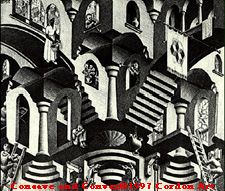|
|
|||||
 |
|||
 |
|||
|
|
||||||||||||||||||||||||||||||||||||||||||||||||||||||||||||||||||||||||||
|
|
|||||||||||||||||||||||||||||||||||||||||||||
| "Day and Night" and "Circle Limit IV" are two well-known examples of M. C. Escher's artistic prints that incorporate tessellating patterns, which cause a figure/ground illusion. The boundaries between the different figures are ambiguous. In the case of "Day and Night," the white geese during the day switch with the black geese who fly at night. In "Circle Limit IV" the angels and devils perceptually flip back and forth. It is difficult, but not impossible, to see both interpretations simultaneously. |
|
|
||||||||||||||||||||||||||||
| "Waterfall"
and "Ascending and Descending" are two of M. C. Escher's most famous prints
of impossible figures. If you follow the course of the water in "Waterfall"
you will see that it flows in an endless cycle, which represented for Escher
another physical impossiblity -- that of perpetual motion.
If you follow the steps around in "Ascending and Descending" you will see that they go around in a perpetual cycle. There appears to be no lowest or highest step. Both prints were based on ideas created by the English mathematician Roger Penrose and his father genetist Lionel Penrose. |
 |
|||||||
|
|
|||||||
| "Concave and Convex" is a beautiful example of an ambiguous scene. Examine the print on the left side and then compare it to the right side. Notice how your interpretation changes from concave to convex. | |||||||
|
|
|||||||